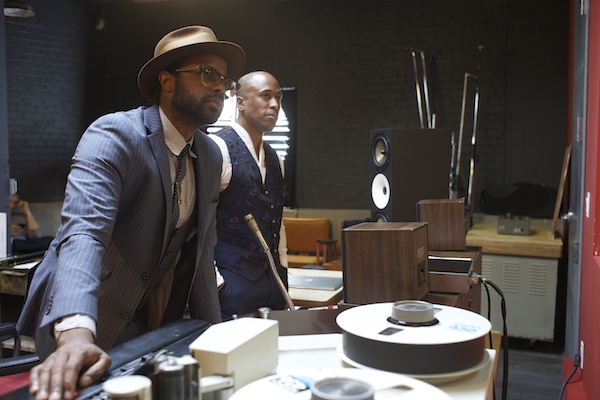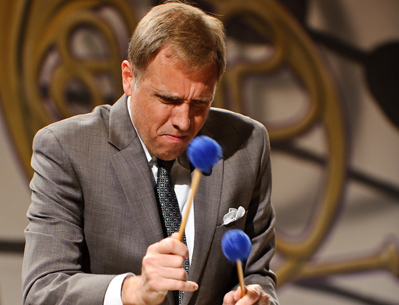Dec 9, 2025 12:28 PM
In Memoriam: Gordon Goodwin, 1954–2025
Gordon Goodwin, an award-winning saxophonist, pianist, bandleader, composer and arranger, died Dec. 8 in Los Angeles.…

Adrian Younge (left) and Ali Shaheed Muhammad take on the concept of jazz’s obsolescence with a new label and compilation of the same name: Jazz Is Dead.
(Photo: Courtesy Linear Labs Music)DJ culture is proving to be an unheralded hero of jazz education.
Sometimes, it’s DJs and producers digging for rare breaks and samples that help listeners develop a broader sense of jazz history—some of which has yet to be celebrated or just willfully redacted. Through DJ culture, we’re better able to connect the seemingly incongruent links among jazz, disco and dance music in the recorded legacies of Roy Ayers, Brian Jackson and Marcos Valle.
Those three artists—and a handful of others—appear on Jazz Is Dead 001, a head-nodding compilation produced by Adrian Younge and Ali Shaheed Muhammad.
“Hip-hop serves as a conduit to the past,” Younge said. “If it wasn’t for hip-hop, there would be a lot of music that I wouldn’t know. If it wasn’t for hip-hop, I wonder if I would have even known who Roy Ayers is. A lot of times in black culture, when we are done with something, we don’t go back. Hip-hop kinda changed that. Hip-hop is vinyl culture taken to the next level.”
Younge and Muhammad are both iconic DJs and producers with serious credentials: Multi-instrumentalist Younge has worked with hip-hop heavyweights like Wu-Tang Clan, Souls of Mischief and Jay-Z; Muhammad was a member of the foundational hip-hop group A Tribe Called Quest, as well as the short-lived neo-soul outfit Lucy Pearl.
During a 2013 tour, Younge met Muhammad and asked him to work on Souls of Mischief’s There Is Only Now. From there, they formally joined forces as The Midnight Hour and produced a 2018 eponymous LP that blended Muhammad’s penchant for jazz-laden hip-hop beats and Younge’s fondness for hazy, Blaxploitation-era psychedelic funk and soul.
After partnering with concert promoter Andrew Lojero and music-industry vet Adam Block, Younge and Muhammad helped launch a jazz concert series with a provocative name: Jazz Is Dead. An alarming moniker, it was designed to celebrate jazz culture, recontextualize it for a younger generation and eschew moldy misconceptions about the art form.
“They should have put Jazz Is Dead in quotations,” said keyboardist Doug Carn, who appears on the compilation’s wistful ballad “Down Deep.” “Jazz, as many of us remembered it, has probably been dead for a long time, because it’s too broad of a field to be narrowly focused. [Jazz Is Dead] is like wearing a T-shirt with Einstein’s picture and saying, ‘I know nothing.’ We all know that it’s far from the truth.”
Within a larger context, Jazz Is Dead resides in a global ecosystem the seeks to recombine groove-based dance musics, hip-hop and jazzier fare that goes back to the late 1980s when the influential UK magazine Straight No Chaser was founded—or when the New York dance party Groove Academy started. Since then, robust transatlantic initiatives like London’s jazz re:freshed and the State’s Revive Music have extended the relationships.
Out of the Jazz Is Dead concert series came the idea for Younge and Muhammad to start a label with the same name. “We want to make the illest jazz label around. We want to make something that’s very raw and very forward-thinking,” Younge said.
Younge’s affinity for lo-fi sonics and music from the Black Jazz and Strata East labels filter heavily into the compilation. “Conexão” featuring João Donato, and the cacophonous “Apocaliptico” featuring Azymuth, sound like less-blunted tracks that Madlib would have concocted with his Yesterdays New Quintet. “We didn’t want to make music that didn’t represent us from a DJ perspective,” Younge said. “These musicians weren’t trying to make trap versions of jazz songs.”
The artists showcased on the compilation—which also includes Gary Bartz—all have full-length LPs slated for release on the imprint. When Younge and Muhammad invited all-involved to their Linear Labs Studio in Los Angeles, it was almost like a time capsule. The space was filled with vintage synthesizers and organs, and they recorded to tape.
“They had a lovely Fender Rhodes with a beautiful sound. The touch was excellent,” said Valle, who’s featured on the entrancing bossa-soul joint, “Nao Saia Da Praca.” He recalled being both excited and curious about the process after Younge and Muhammad asked him to contribute, because they only had five days to write the music, lyrics, arrangements and to record. After Valle, drummer Malachi Morehead and Younge—on bass—recorded the basic tracks, Muhammad and Younge added overdubbed instrumentation and vocals.
“When I saw how everything was happening, I realized that it was an incredible experience,” Valle said. “Even for the vocals—the results were so surprising, because when we recorded the bass, drums and Rhodes, I started creating the vocal arrangements very hurriedly. We didn’t have time to think about changing a phrase here or there. I understood that they were looking for my first impressions of the songs. They were trying to capture that moment. It was totally different from what I did before.”
On Jazz Is Dead 001, Younge and Muhammad divvy up multiple instrumental roles, switching among bass, guitar, flute, saxophone, synthesizers, organ, percussion and drums. To add mystique, the compilation doesn’t specify exactly which instruments they each play on each track. “Ali and I both started our careers as DJs, then sampling and making beats. We got to the point of realizing that in order for us to be who we really want to be, we had to learn how to play some instruments,” Younge said.
He likens their studio-based music making to the Mizell Brothers, who worked with jazz-funk titans like Bartz and trumpeter Donald Byrd.
“They would have a composition prepared. They would have players come in, and then the main artist would come in and do their thing,” Younge explained. “They would figure it out on the spot and do it all at once. They would do some overdubs later, but they recorded it all at once. When you’re doing this, there is no ‘can you take this track off’ or ‘punch [these bars] in here or there.’”
Muhammad added: “The artists ... in the studio with us have been artists that have been in both of our record collections. They are like family photos hanging on a wall. Because we’ve listened to their music for so many years, it’s as if our lives were preparing us for this moment.” DB

Goodwin was one of the most acclaimed, successful and influential jazz musicians of his generation.
Dec 9, 2025 12:28 PM
Gordon Goodwin, an award-winning saxophonist, pianist, bandleader, composer and arranger, died Dec. 8 in Los Angeles.…

Belá Fleck during an interview with Fredrika Whitfield on CNN.
Jan 13, 2026 2:09 PM
The fallout from the renaming of the John F. Kennedy Center for the Performing Arts to include President Donald…

Flea has returned to his first instrument — the trumpet — and assembled a dream band of jazz musicians to record a new album.
Dec 2, 2025 2:01 AM
After a nearly five-decade career as one of his generation’s defining rock bassists, Flea has returned to his first…

Dec 11, 2025 11:00 AM
DownBeat presents a complete list of the 4-, 4½- and 5-star albums from 2025 in one convenient package. It’s a great…

Vibraphonist Chuck Redd found himself in the midst of a political firestorm after canceling his gig Dec. 24 at the newly renamed Trump Kennedy Center.
Jan 6, 2026 2:32 AM
The Board of Trustees at Washington, D.C.’s Kennedy Center for the Performing Arts voted on Dec. 18 to rename the…